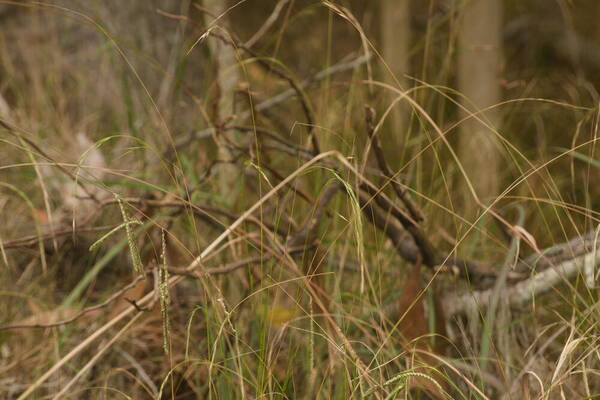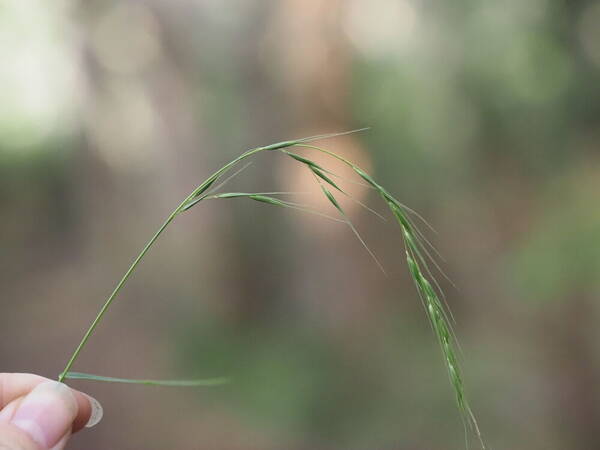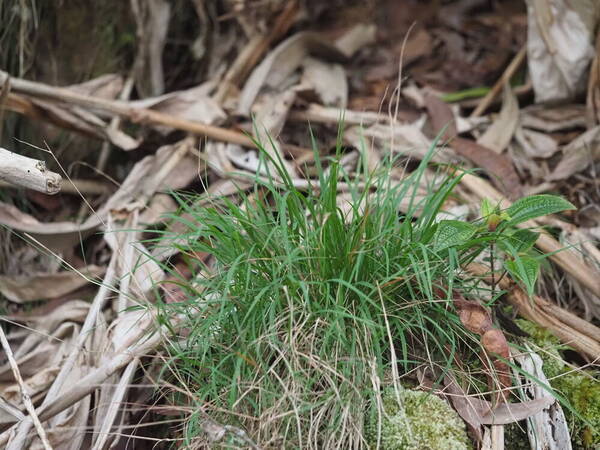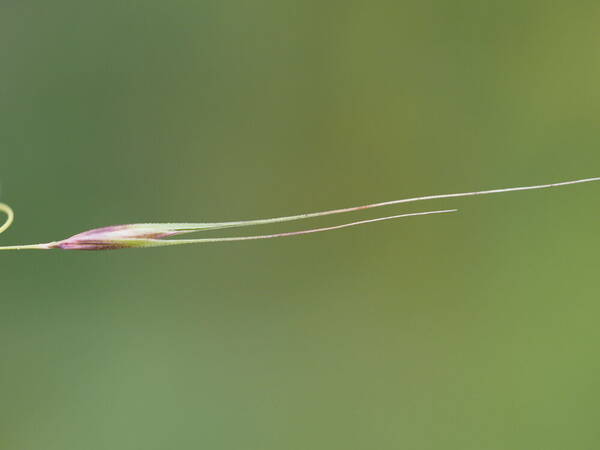Info
Subfamily: Ehrhartoideae
Genus etymology: Microlaena = "small cloak" [Greek] referencing the small glumes
Species etymology: stipoides = "resembling Stipa L." [Latin] refering to the callus and long awn which resemble Stipa
Photosynthetic type: C3 (cool season)
Nativity: naturalized - accidental
First recorded in Hawaiʻi: 1902
Map


Inflorescence





Plant


Habit




Spikelets








Landscape


Rhizomes



Description
Habit: Perennial. Cataphylls evident. Rhizomes short. Culms geniculately ascending, or decumbent; 30-75 cm long; rooting from lower nodes. Ligule a ciliolate membrane. Leaf-blades 2.5-25 cm long; 1-5(-10) mm wide. Inflorescences: Inflorescence a panicle, or composed of racemes. Panicle open; linear; effuse; equilateral, or nodding; 7-17 cm long. Primary panicle branches bearing 1-3 fertile spikelets on each lower branch. Panicle branches capillary. Racemes single (reduced panicle). Spikelets solitary. Fertile spikelets pedicelled. Pedicels filiform; 1-15 mm long. Spikelets: Spikelets comprising 2 basal sterile florets; 1 fertile florets; without rhachilla extension. Spikelets linear; laterally compressed; 8-14 mm long; breaking up at maturity; disarticulating below each fertile floret. Floret callus evident, or elongated; 0.1-2 mm long; pubescent. Fertile Spikelets: Spikelets comprising 2 basal sterile florets; 1 fertile florets; without rhachilla extension. Spikelets linear; laterally compressed; 8-14 mm long; breaking up at maturity; disarticulating below each fertile floret. Floret callus evident, or elongated; 0.1-2 mm long; pubescent. Glumes: Glumes both absent or obscure (or minute, persistent). Florets: Basal sterile florets similar; barren; without significant palea. Lemma of lower sterile floret lanceolate; 5-10 mm long; coriaceous; 1-keeled; 5-7 -veined; scabrous; acuminate; awned. Awn of lower sterile floret 5-20 mm long. Lemma of upper sterile floret lanceolate; 8-12 mm long; 1.2-1.6 length of lower sterile floret; coriaceous; acuminate; awned. Awn of upper sterile floret 8-20 mm long. Fertile lemma lanceolate; 7-10 mm long; membranous; keeled; 5-7 -veined. Lemma midvein scabrous. Lemma apex acute, or acuminate; muticous, or mucronate. Palea linear; 0.75 length of lemma; membranous; thinner on margins; 1 -veined; 1-keeled. Palea keels ciliate. Florets: Lodicules 2; ovate; membranous. Anthers 4; 3-4 mm long. Fruits Caryopsis with adherent pericarp; linear. Cleistogene Cleistogenes present. Distribution: Africa: south. Asia-tropical: India, Malesia, and Papuasia. Australasia: Australia and New Zealand. Pacific: south-central and north-central.
(Description source: Clayton, W.D., Vorontsova, M.S., Harman, K.T. and Williamson, H. (2006 onwards). GrassBase - The Online World Grass Flora. Available at https://powo.science.kew.org )
Slender rhizomatous perennials; culms ascending or erect, usually decumbent at base, 30-75 cm tall, glabrous. Sheaths 2-6 cm long, shorter than internodes, glabrous or retrorsely scabrous; ligule membranous, 0.2-0.5 mm long, margins erose; blades flat, 3-8(-14) cm long, 2-3 mm wide, glabrous or scaberulous, margins scabrous. Inflorescences paniculate, suberect to nodding, (4-)10-19 cm long, narrow, usually unbranched; spikelets widely spaced, paired or solitary, chasmogamous or cleistogamous, appressed along the slender axis, each one ca. 10 mm long (excluding awns), pedicels 1-2 mm long, rachilla somewhat elongate above glumes and between sterile lemmas; glumes membranous, nerveless, first glume 0.2-0.5 mm long, apex acute, second glume 0.5-0.7 mm long, apex acute or bifid; sterile lemma similar to glumes, coriaceous, obscurely 5-nerved, the nerves scaberulous, margins membranous, apex with a scabrous awn 8-12 mm long, callus conspicuous, appressed silky pilose, the hairs ca. 1 mm long; fertile lemma 5-6 mm long, enclosed within margins of uppermost sterile lemma, obscurely 7-nerved, somewhat keeled, scabrous on upper part of keel, apex apiculate; palea membranous, narrow, linear, shorter than lemma, 1- nerved, keeled, the keel sparsely ciliate, margins hyaline. Caryopsis yellow, narrow, somewhat compressed, 5-6 mm long. [2n = 40.]
(Description source: O’Connor, P.J. 1990. Poaceae, pp. 1481–1604. In: Wagner W.L., Herbst D.R. & Sohmer S.H. (eds.)., Manual of the flowering plant of Hawaiʻi. Vol. 2. University of Hawaii Press & Bishop Museum Press, Honolulu )